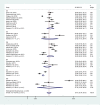Prevalence of overweight and obesity in Nigeria: Systematic review and meta-analysis of population-based studies
- PMID: 36962450
- PMCID: PMC10021772
- DOI: 10.1371/journal.pgph.0000515
Prevalence of overweight and obesity in Nigeria: Systematic review and meta-analysis of population-based studies
Abstract
In Nigeria, several studies have assessed the prevalence of overweight/obesity with different reports. The purpose of this study was to use a systematic review and meta-analysis to analyze these overweight and obesity reports from different locations in Nigeria over the last ten years. In addition, there was a dearth of systematic reviews and meta-analyses on the prevalence, trends, and demographic characteristics of overweight and obesity in the country. This was a systematic review and meta-analysis of cross-sectional population-based studies among adult Nigerians on the prevalence of overweight/ obesity (defined by body mass index) published from January 2010 to December 2020. Relevant abstracts were scrutinized and articles that included adults of all age groups and were not restricted to a particular group of people (e.g. university community) were selected. Each article was scrutinized by more than 2 authors before selection. The prevalence of overweight/obesity among all participants, among men and among women in Nigeria and its 6 geopolitical zones was determined. All analyses were performed using STATA version 14 (Stata Corp. College Station, Texas, USA). Thirty-three studies were selected and the number of participants was 37,205. The estimated prevalence of overweight and obesity was 27.6%, and 14.5% respectively. The prevalence of overweight among men and among women was 26.3% and 28.3% respectively and, the prevalence of obesity among men and women was 10.9% and 23.0% respectively. The prevalence of overweight in the 6 geopolitical zones was Southeast 29.3%, Southwest 29.3%, South-south 27.9%, Northwest 27.2%, North-central 25.3%, Northeast 20.0% and obesity South-south 24.7%, Southeast 15.7%, Southwest 13.9%, Northwest 10.4%, North-central 10.2%, Northeast 6.4%. Egger's tests showed no statistically significant publication bias among the studies that reported the overweight and obesity prevalence respectively (p = 0.225, P 0.350). The prevalence of overweight/obesity in Nigeria is high. The southern geopolitical zones had a higher prevalence of overweight/obesity.
Copyright: © 2022 Chukwuonye et al. This is an open access article distributed under the terms of the Creative Commons Attribution License, which permits unrestricted use, distribution, and reproduction in any medium, provided the original author and source are credited.
Conflict of interest statement
The authors have declared that no competing interests exist.
Figures









References
-
- Templin T, Cravo Oliveira Hashiguchi T, Thomson B, Dieleman J, Bendavid E (2019) The overweight and obesity transition from the wealthy to the poor in low- and middle-income countries: A survey of household data from 103 countries. PLoS Med 16(11): e1002968. doi: 10.1371/journal.pmed.1002968 - DOI - PMC - PubMed
-
- WHO. Media Centre [Accessed December 3, 2020]: Obesity and overweight 2016. Available at: http://www.who.int/mediacentre/factsheets/fs311/en/.
-
- GBD 2016 Risk Factors Collaborators Global, regional, and national comparative risk assessment of 84 behavioural, environmental and occupational, and metabolic risks or clusters of risks, 1990–2016: a systematic analysis for the Global Burden of Disease Study 2016. Lancet. 2017;390:1345–1422. doi: 10.1016/S0140-6736(17)32366-8 - DOI - PMC - PubMed
LinkOut - more resources
Full Text Sources
